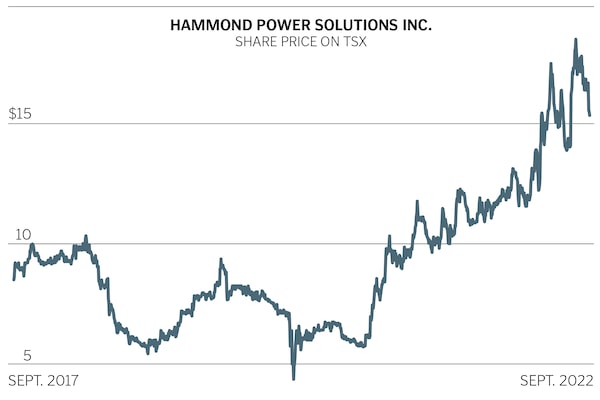
High voltage transmission tower. Symmetrical composite.shaunl/iStockPhoto / Getty Images
Revenue (2021) $380.2 million | Profit $15.2 million
Three-year share price gain 96% | P/E ratio (trailing) 8.2
Launched in 1917, HPS (as the company refers to itself) is now the leading maker of dry electrical transformers in North America, and it’s expanding fast in Mexico, India and other countries. Virtually any electric device needs a transformer to step voltage up or down. In HPS’s early years, that meant tube radios. Today, explains CEO Bill Hammond, the third generation of his family to run the company, transformers range from something tiny you can fit in your hand to the size of a car garage, and go into things such as EV recharging stations, renewable power generation facilities “and so many other new technologies that we never foresaw.”
Dry-type transformers, by the way, are cooled by air, while wet-type ones are filled with oil or other liquids. Hammond, who’s 70, was promoted to the top job in 2001, when sales were $75 million. They’ve increased solidly since. The stock price is another story. The shares drifted sideways after the 2008-09 financial crisis, although they’ve surged again since the pandemic. “If you could tell me how the stock market works, that would help us significantly,” Hammond says. He sees his company not as a sleepy value play, but as “a growth stock that’s undervalued.”
To him, HPS’s prospects are stronger than those of many startups, and it has a solid financial track record. Lots of glitzy newbies trade at price-to-earnings ratios of 40, 50 or more—if they have earnings at all.
Since the 1980s, many other Canadian-owned manufacturers have fled or folded. But remaining resolutely Canadian helped HPS, Hammond says, because traditionally, it had to manufacture a full product line—”we had to be all things to all people.” The company grew bigger than its specialist U.S. rivals, as well as divisions of multinationals such as Siemens, Eaton and Schneider Electric.
After the financial crisis, many of its biggest customers in mining and oil and gas were slammed by sector downturns. But the company has expanded into other industries such as induction heating products, which are used in silicon chip and fibre-optic cable manufacturing. In recent years, HPS has also caught a tailwind as the world electrifies. And mining and petroleum are now rebounding.
Hammond may also be more diplomatic than he needs to be about his family’s 66% control of HPS through four-for-one multiple voting shares. Like many money managers, he argues such arrangements provide long-term stability. He doesn’t have to dwell on quarterly results or bet big on one flashy new technology. “There’s nothing sexy about our business,” he says, “but we do it well.”

Your time is valuable. Have the Top Business Headlines newsletter conveniently delivered to your inbox in the morning or evening. Sign up today.
 John Daly
John Daly